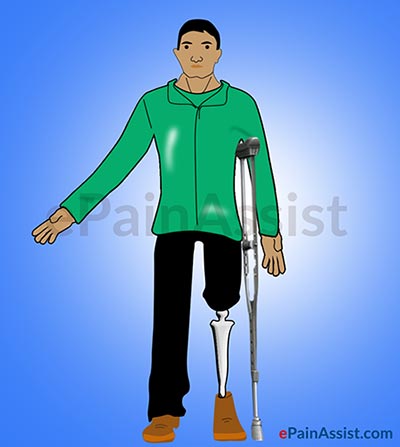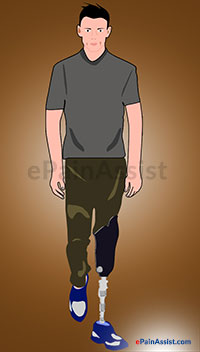What is Phantom Pain?
Phantom pain is a pain or a sensation which an individual feels as if it is coming from a part of body which no longer exists, e.g. after an amputation of a limb, the individual feels pain where the limb existed before. Phantom pain is not limited to limb removal. It can be felt after surgical removal of other body parts too, such as eye, tongue, breast or penis. Phantom pain can also be felt after spinal cord injury or nerve avulsion. The intensity of phantom pain differs from person to person. More than half of the amputees experience phantom pain at some point in their lives and few continue feeling it for the rest of their life.[1]

However, in some patients, Phantom pain improves gradually without any treatment whereas others require medications and therapies to manage phantom pain.
In the past, phantom pain was thought to be a psychological phenomenon, but over the years it has been proved that phantom pain is very much a real pain which is felt by the patient to the point of making one’s life uncomfortable. It originates from the brain and spinal cord.[2]

Classification and Types of Phantom Pain
There are various types of sensations that a patient may feel with an amputated limb.
- Sensations pertaining to the posture, length and volume of the phantom limb such as a feeling that the phantom limb is acting like a normal limb e.g. sitting with the knee flexed. Sometimes, the amputee may feel that the phantom limb is as heavy as the other limb and sometimes the amputee experiences a sensation known as telescoping where one feels as if the phantom limb is gradually decreasing in length over time.
- Amputee may have sensation of movement in the phantom limb such as one may feel as though the phantom foot is moving.
- Other sensations which an amputee may feel are sensations of touch, temperature, pressure and itchiness. Many amputees report feelings of tingling, itchiness, heat, and pain in the phantom limb.
Causes and Risk Factors of Phantom Pain
- The exact cause of phantom pain is not clear, but the pain seems to originate from brain and spinal cord.
- Imaging scans such as Magnetic Resonance Imaging (MRI) and Positron Emission Tomography (PET) have shown activity in specific parts of the brain when the patient is experiencing phantom pain.
- It is the belief of many professionals that phantom pain may partially be a result of mixed signals from the brain. After an individual has had an amputation, certain regions of brain and spinal cord stop receiving input from the amputated limb and as they try to adjust to this new condition, the result is a sensation or pain in the region of the amputated limb.
- Other factors which are thought to contribute to phantom pain are: Damaged nerve endings, formation of scar tissue at the amputation site and recollection of pre-amputation pain by the patient.[3]
There are some risk factors which increase the chances of a patient feeling phantom pain. These risk factors are:
Pre-amputation Pain:
Research has shown that patients who experience pain before the actual amputation of the limb are more prone to experience pain after the amputation also, especially immediately after the amputation of limb. The reason for this is the memory of the pre-amputation pain still lingers in the mind of the patient and the brain continues to send pain signals even after the amputation is done.[4]
Ill-Fitting Prosthesis (Artificial Limb):

If the prosthesis does not fit properly on the stump, then it can cause damage or injury to the surrounding structures resulting in pain. Prosthesis should always be fitted under medical supervision to ensure that it attaches properly.
Stump Pain:
Patients who suffer from stump pain may also experience phantom pain. The cause of the stump pain may be damaged nerve endings or abnormal growth at the stump.[5]
Pathophysiology of Phantom Pain
Monitoring of the patients and experimental theories has led to various mechanisms and neurological basis for phantom pain. There is very little information as to the actual mechanism that causes phantom pain, but there are some theories given by experts which overlap each other. Previously it was thought that the stump neuromas were responsible for phantom pain. Although they can be one of the causes of phantom pain, they are not solely responsible for it, as patients with congenital limb deficiency can also suffer from phantom pain. This implies that the painful sensations are due to a central representation of the limb. Presently, there are many theories which are based on cortical reorganization and altered neurological pathways. Even though they are closely linked, they are divided into spinal, peripheral and central mechanisms.[6]
Signs and Symptoms of Phantom Pain
Many individuals who have had their limb amputated relate that they sometimes feel as if their amputated limb is still present. This condition where the individual gets the feeling as if the amputated part still exists, but feels no pain is known as phantom limb sensation. This can also occur in individuals who don’t have limbs by birth. Phantom limb sensations also include feelings of warmth, itchiness, cold and tingling. Phantom limb sensations are different from phantom pain. The former, as the name suggests, are only sensations and not actual pain. Pain present in the stump of an amputated limb should not be confused with phantom pain. Phantom pain is the pain which feels as if it is coming from a body part which no longer exists. The feeling of pain from an amputated limb or other body part is the determining symptom of phantom pain.
Some of the Characteristics of Phantom Pain are:
- Pain starting within the first few days of amputation.
- Pain occurs in episodes and is not constant.
- Pain appears to originate from the part of the limb which is situated farthest from the body, e.g. pain in foot of an amputated leg.
- The nature of the pain can be stabbing, shooting, squeezing, boring, burning or throbbing.
- Pain may be provoked by certain conditions such as changes in the weather, emotional stress or compression on the remaining area of the limb.

Treatment of Phantom Pain
Treating phantom pain can prove to be difficult. The common line of treatment followed by doctors is usually medications followed by noninvasive therapies comprising of acupuncture or transcutaneous electrical nerve stimulation (TENS). If the patient does not benefit from this, then more-invasive options are considered such as implanted devices or injections. Surgery is only considered if all the above options fail.
- Lifestyle Modifications go a long way in alleviating phantom pain. Patient can take the following steps to reduce phantom pain:
- Patient should involve himself in other activities such as reading, listening to music or watching TV to distract him/her from phantom pain.
- Patient should try meditation or other such activities for relaxation in order to reduce stress and tension in the muscles thereby alleviating the pain.
- Staying physically active such as doing exercises or gardening, cycling, walking or swimming also helps in alleviating the symptoms of phantom pain.
- Patient should follow his/her physician’s instructions and take medications on time. Medical advice should be taken before starting any herbal medicines.
- Patient should take the utmost care when changing or removing the prosthesis as there is a likelihood of damaging the adjacent structures and causing more pain.[7]
- Medications: There are no medications specifically for treating phantom pain. Some medications for treating other conditions have been helpful in alleviating nerve pain. Different patients benefit from different medications so a different combination of medications need to tried to find out which works best for a particular patient. Some of the medications which help in relieving phantom pain are
- Antidepressants: Pain due to damaged nerves can be relieved by taking tricyclic antidepressants such as amitriptyline and nortriptyline. Antidepressants also help in improving sleep, which can make the patient feel better.
- Anticonvulsants: Drugs used for epilepsy such as gabapentin (Neurontin) and carbamazepine (Carbatrol, Tegretol) also help in alleviating nerve pain. They act by calming the damaged nerves thereby slowing down or preventing uncontrolled pain signals.
- Narcotics: In some patients, codeine and morphine, which are opioid drugs, help in relieving phantom pain. Patients having a history of substance abuse should avoid these medications. Side effects of narcotics include sedation and constipation.[8]
- Noninvasive methods which are helpful in alleviating phantom pain comprise of: Transcutaneous Electrical Nerve Stimulation (TENS), use of electric artificial limb, mirror box and acupuncture.
- Minimally Invasive methods such as local anesthetic or steroid injections, spinal cord stimulation and intrathecal delivery system may also help in relieving phantom pain.
- Surgery: If all the above methods fail, then surgery is done as a last resort. Surgery comprises of stump revision or neurectomy and deep brain stimulation.
Tests to Diagnose Phantom Pain
- As mentioned earlier, imaging scans such as magnetic resonance imaging (MRI) and positron emission tomography (PET), have shown activity in specific parts of the brain when the patient is experiencing phantom pain. However, there are no specific tests for diagnosis of phantom pain.[9] Diagnosis is done on the basis of history given by the patient, sign and symptoms and events occurring before the phantom pain.
- Patient should give a detailed history such as the cause of amputation, site of amputation, the type of procedure done and post-amputation activities. Sometimes, muscle pain resulting from overstraining of the muscles near the stump is confused with phantom pain. Diagnosis and treatment depends on the patient’s history and symptoms.
- https://www.mayoclinic.org/diseases-conditions/phantom-pain/symptoms-causes/syc-20376272
- https://en.wikipedia.org/wiki/Phantom_pain
- https://journals.plos.org/plosone/article?id=10.1371/journal.pone.0240431
- https://www.physio-pedia.com/Phantom_Limb_Pain
- https://www.mayoclinic.org/diseases-conditions/residual-limb-pain/cdc-20447167
- https://journals.lww.com/rca/fulltext/2014/42010/pathophysiology_and_treatment_of_phantom_limb.9.aspx
- http://www.sciencepub.net/nurse/bnj060320/03_36751bnj060320_20_34.pdf
- https://www.amputee-coalition.org/limb-loss-resource-center/resources-for-pain-management/managing-phantom-pain/
- https://www.mayoclinic.org/diseases-conditions/phantom-pain/diagnosis-treatment/drc-20376278
